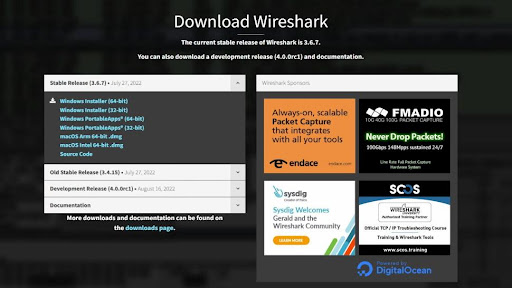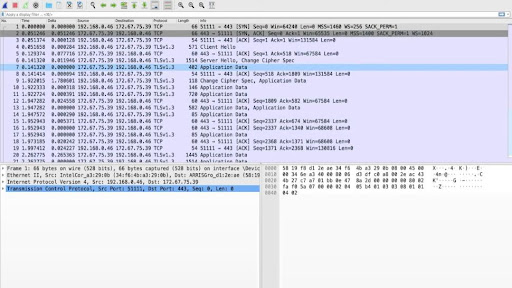TechRadar Verdict
Wireshark is a free, open-source vulnerability scanning tool that relies on packet sniffing to get a precise picture of network traffic. It’s a terrific tool for troubleshooting all sorts of issues and bugs, it works perfectly with multiple OS’, and it helps capture the traffic traveling through the network. Unfortunately for beginners, Wireshark is geared towards tech-savvy users only.
Pros
- +
A wide array of display filters
- +
It’s open-source and free for everyone
- +
Live capture and offline analysis
- +
Packed with powerful features
- +
Runs on multiple OS’
Cons
- -
Not for non-tech-savvy users
Why you can trust TechRadar
Whether you’re a cyber security professional, software development enthusiast, or aspiring network engineer – if you want to tackle network troubleshooting that includes inspecting individual packets, you’re probably considering using Wireshark.
It’s a go-to network packet analyzer - it’s open-source, cost-free, and one of the best applications for capturing and analyzing network traffic available today. Wireshark will allow you to see what’s happening inside your network and you’ll be able to do it at a microscopic level.
Started as an online project by a young yet enthusiastic Gerald Combs in 1998, Wireshark came a long way from a simple, four-protocols-only network analyzing tool to becoming a benchmark for network many diagnostic tools we know today. Thanks to the committed community of networking experts across the world, Wireshark still thrives.
Wireshark’s official site is unsurprisingly blue and shark-themed but you won’t feel out of water there – it’s intuitive, simple to use, and offers an all-inclusive introduction to their flagship product.
You can also pay a visit to Wireshark’s simple-looking blog and if you do you’ll discover some well-written posts including insider tips and tricks.
As for social networking sites, Wireshark invites its users to follow them on Twitter.

Plans and pricing
Wireshark is open-source, free-to-use software, which means that you can download and use it as long as you want without having to spend any money – so, no pricing, no tiered plans, and no limits on the number of computers you can use Wireshark on.
What’s more, all source code is in the public domain under the general public license (GPL) which makes it easy for enthusiasts to add new protocols to Wireshark, whether as plugins or build them into the code.
Wireshark works with most major and minor operating systems (OS’) including Windows, Linux, Mac, OS X, FreeBSD, NetBSD, and OpenBSD.

Features and functionality
Being one of the most popular packet sniffers on the planet, Wireshark is also packed with features that provide three primary functionalities - packet capture, filtering, and network visualization.
Much like most network packet analyzers, Wireshark tunes in with a network connection in real-time and captures whole streams of traffic – as many as thousands of packets at once.
After this, it can check all captured data by applying filters and getting rid of all irrelevant information – thus, you’ll get only the information that’s worth checking out.
And then, finally, like any solid packet sniffer, Wireshark will let you dive deep into a network packet while allowing you to visualize the whole conversation and network streams.
While Wireshark can be used for a couple of things (such as tracing connections, inspecting the content of suspicious network transactions, and identifying microburst congestion), for most users it’s a go-to tool for troubleshooting networks with performance problems.
Other noteworthy features of Wireshark include a wide variety of supported capture file formats (tcpdump, Pcap NG, Catapult DCT2000, Cisco Secure IDS iplog, Microsoft Network Monitor, and much more), decryption support for plenty of protocols (such as IPsec, ISAKMP, and Kerberos), application of coloring rules to the packet list for simpler analysis, and capacity to export output to XML, PostScript, CSV, or plain texts.

Interface and ease of use
First of all, if you have little to no understanding of network protocols, this is probably not the tool for you. To properly use Wireshark, you need to possess some technical know-how such as a TCP 3-way handshake and protocols such as TCP, UDP, and DHCP.
Wireshark is best suited for security agencies, educational establishments, small to mid-sized businesses, and nonprofit organizations, but it can also be used as an educational tool for soon-to-be security experts.
We should also note that while Wireshark can prove useful in preventing zero-day attacks once the alarm bells have been raised, it’s not an actual intrusion detection system (IDS) and shouldn’t be used as such.
Also, although Wireshark can apply color coding for the sake of user-friendliness and displays malformed packets, there are no alerts. However, graphical tools for visualizing statistics make it easy to spot changes and common trends.
So, to sum it up, the simplest part of utilizing Wireshark is downloading and installing it (particularly if you use Windows) – it gets complicated after that, so beginners beware.
Customer support
Since we’re talking about an open-source solution, we didn’t exactly expect to find a dedicated technical support team ready to stretch out a helping hand around the clock – Wireshark is closer to a do-it-yourself sort of solution. Nevertheless, there are several self-support options you can explore.
Go to Wireshark’s official site and click on the “Get Help” dropdown menu which will give you a choice between posting a question on the forum (and patiently waiting for the reply), consulting a FAQ section, seeking answers on the documentation page, visiting their wiki site, and going to the issue tracker. Although you’ll find a few fine how-to guides (including video how-tos), these aren’t fit for first-time users.

Competition
Much like Wireshark, Ettercap is a free, open-source, cross-platform software created for network protocol analysis and security auditing. However, it does little to disguise the fact it was designed to make hacking easier which makes it a top choice for all those looking for man-in-the-middle attack tools. Wireshark, on the other hand, is better for packet sniffing.
If you’re searching for a Wireshark alternative for Windows and don’t mind paying a pretty penny for it - check out a browser-based packet sniffer called Cloud Shark. It’s somewhat simpler to use than Wireshark but lacking in terms of features.
OmniPeek is another noteworthy alternative to Wireshark, but it doesn’t come free of cost. With a proper add-on, OmniPeek can work as a network management system as well as a packet sniffer and it surpasses Wireshark in terms of capabilities. However, it runs on Windows only.
Final verdict
To sum it all up, Wireshark is a powerful, professional, and highly helpful software for troubleshooting all types of errors, issues, and bugs. While it came a long way from its past versions, Wireshark stayed somewhat complicated to start with – and that’s the only significant flaw we could find with it, so go and check it out.
- Keep your business safe with the best endpoint protection
Sead is a seasoned freelance journalist based in Sarajevo, Bosnia and Herzegovina. He writes about IT (cloud, IoT, 5G, VPN) and cybersecurity (ransomware, data breaches, laws and regulations). In his career, spanning more than a decade, he’s written for numerous media outlets, including Al Jazeera Balkans. He’s also held several modules on content writing for Represent Communications.
